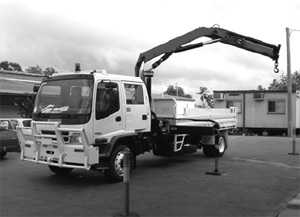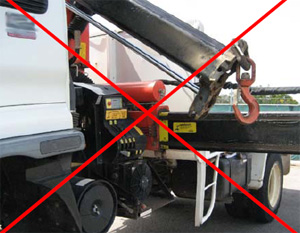Vehicle loading cranes
Issued: 4 February 2010
Last Updated: 15 September 2017
Purpose
The purpose of this safety alert is to:
- alert operators of vehicle loading cranes (VLCs) of the need to follow the manufacturer's operating instructions
- provide safety guidance for owners and employers.
Background
VLCs can be dangerous when they are not operated in accordance with the manufacturers' instructions.
In Townsville recently a worker received fatal head injuries while operating a VLC. While the operator was standing at the left hand control station folding up the boom, the boom moved downwards and struck him.
Another operator was fatally injured in a similar way in early 2009 while operating a VLC in Canberra.
Photograph 1: Shows a VLC on a truck with the boom unfolded. Truck with a VLC. |
Photograph 2: Shows the position of the boom in an unsafe position. The boom is in an upside down position directly above the left hand control station where the operator may be standing. Unsafe situation when boom is located directly above control station. |
The operation of a VLC is difficult in comparison to the operation of a typical mobile crane because the outer boom becomes upside down when it is folded into its travelling position. This means that the way the controls move different parts of the crane can change depending on the position of the crane boom. For example, when the outer boom is upside down the luff control levers will cause this part of the boom to move in the opposite direction to when it is in lifting mode.
Recommended control measures
Employers and owner-operators
- Plan to purchase VLCs that are operated by remote control so that the operator can stand clear from any potential crush zone under the boom. A remote control also enables the operator to be in a much better position to view the crane operation. Note: with a remote control unit, the operator still needs to stand in a position clear of any potential crush zone, the crane and the load.
- Where you have VLCs with side controls, and the boom needs to be telescoped to a partially extended position to latch it, consider making the following modifications to the unit:
- Ensure the boom latching system on the VLC can be lined up by either telescoping the boom in or out. This may require retro-fitting units with a hydraulic valve system that ensures the larger boom section is telescoped out first.
- Mark the boom section with high visibility paint or decals to identify the latching position.
Note: owners of VLCs should consult with the VLC manufacturer prior to making any modifications to the unit. Modifications are not to interfere with the safe operation of the unit in any way.
Also ensure:
- operators of a VLC with a capacity of ten metre tonnes or more hold a high risk work licence to operate a vehicle loading crane
- VLC operators receive documented familiarisation training on the safe operation for the specific make and model of VLC they operate
- the VLC operator's manual is kept in the truck cabin
- VLC units are regularly maintained to guarantee their safe condition.
VLC operators
- Always follow the manufacturers' instructions when you operate the VLC - whether to unfold, fold or lift loads on the crane.
- Never position the boom directly above your head (as shown in photograph 2 directly above the operator control station).
- Make sure you receive familiarisation training on the make and model of VLC you operate.
- Do not operate the crane if it is malfunctioning - report the defect to management.
- If you are operating a VLC with a capacity of ten metre tonnes or more, you must hold a high risk work licence to operate the equipment.
Further information
Further information on the safe use of vehicle loading cranes is included in the:
- Mobile crane Code of Practice 2024 (PDF, 2.29 MB)
- Vehicle loading cranes self-assessment tool (PDF, 0.25 MB)
- Australian Standard, AS 2550.11: Cranes, hoists and winches - safe use Part 11: Vehicle-loading cranes.
Read more on high risk work licenses or call us on 1300 362 128.

